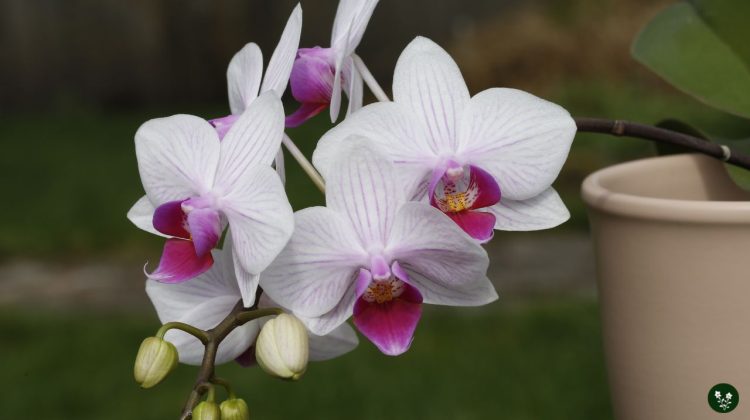
With their unmatched beauty, scarcity, and variety, orchids have long fascinated plant enthusiasts and collectors.
As members of one of the largest and most diverse families of flowering plants, Orchidaceae, orchids can be found on every continent except Antarctica, thriving in various habitats.
With over 25,000 known species and over 100,000 hybrids, it’s no wonder that orchids have become popular houseplants.
Understanding the different types of orchids is essential for providing proper care and ensuring their vibrant blooms brighten our living spaces.
Many orchid varieties are quite forgiving and suitable for beginners as long as their specific needs are met, including light, temperature, and humidity requirements.
This article will explore 35 different types of orchids that can be grown as houseplants, showcasing their unique features and providing essential care tips.
Whether you’re just starting your orchid journey or looking to expand your existing collection, this guide will introduce you to a world of captivating orchid varieties, each with its distinctive charm.
Dive in and discover the enchanting world of orchids as houseplants!
In this article, we'll cover
- 1. Phalaenopsis (Moth Orchid)
- 2. Cattleya (Corsage Orchid)
- 3. Oncidium (Dancing Lady Orchid)
- 4. Dendrobium (Spray Orchid)
- 5. Paphiopedilum (Lady’s Slipper Orchid)
- 6. Vanda (Singapore Orchid)
- 7. Cymbidium (Boat Orchid)
- 8. Miltoniopsis (Pansy Orchid)
- 9. Brassia (Spider Orchid)
- 10. Masdevallia (Triangle Orchid)
- 11. Epidendrum (Star Orchid)
- 12. Ludisia (Jewel Orchid)
- 13. Coelogyne (Necklace Orchid)
- 14. Encyclia (Cockleshell Orchid)
- 15. Maxillaria (Tiger Orchid)
- 16. Dendrochilum (Chain Orchid)
- 17. Zygopetalum (Zygo Orchid)
- 18. Bulbophyllum (Umbrella Orchid)
- 19. Odontoglossum (Toothed Lip Orchid)
- 20. Catasetum (Helmet Orchid)
- 21. Stanhopea (Upside-Down Orchid)
- 22. Ansellia (Leopard Orchid)
- 23. Brassavola (Lady of the Night Orchid)
- 24. Renanthera (Fire Orchid)
- 25. Laelia (Sun Orchid)
- 26. Lycaste (Angel Orchid)
- 27. Psychopsis (Butterfly Orchid)
- 28. Angraecum (Comet Orchid)
- 29. Aerangis (Air Orchid)
- 30. Neofinetia (Samurai Orchid)
- 31. Phaius (Nun’s Orchid)
- 32. Eria (Foxtail Orchid)
- 33. Sobralia (Queen Orchid)
- 34. Tolumnia (Equitant Oncidium)
- 35. Dracula (Monkey Face Orchid)
1. Phalaenopsis (Moth Orchid)
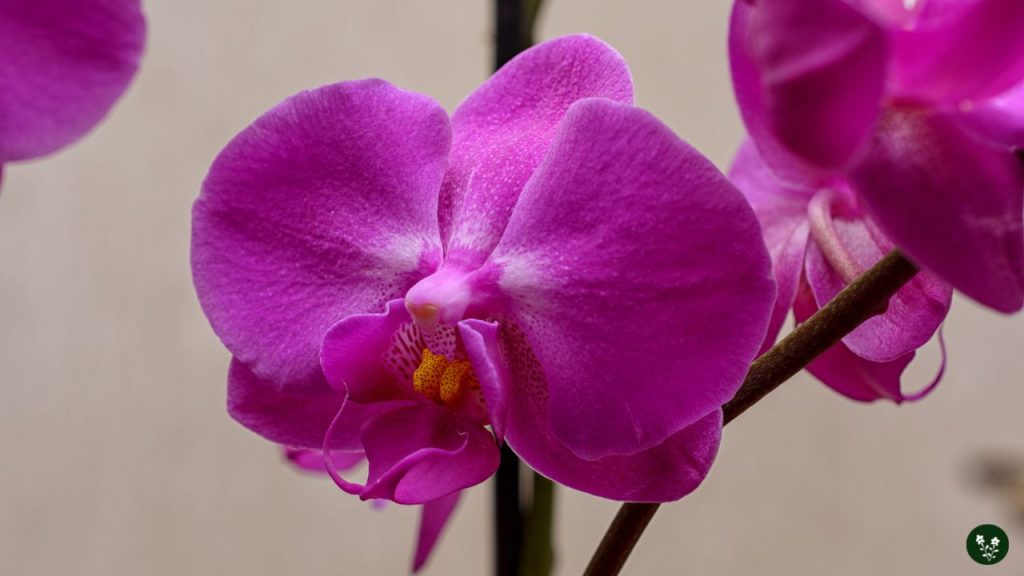
Phalaenopsis orchids, also known as Moth Orchids, are among the most popular houseplants due to their elegant, long-lasting blooms and easy care requirements.
Native to Southeast Asia, these orchids are known for their graceful, arching flower spikes that bear delicate, moth-like flowers.
The blooms come in various colors, including white, pink, purple, and yellow.
You can enjoy their exquisite blooms for up to three months with proper care, making them an excellent choice for first-time orchid growers.
Care Guide for Moth Orchid:
| Native area | Southeast Asia |
| Height | 1-2 ft |
| Light needs | Low to medium |
| Water needs | Weekly |
| Temperature | 60-85°F (15-29°C) |
| Flowering Season | Winter-Spring |
2. Cattleya (Corsage Orchid)
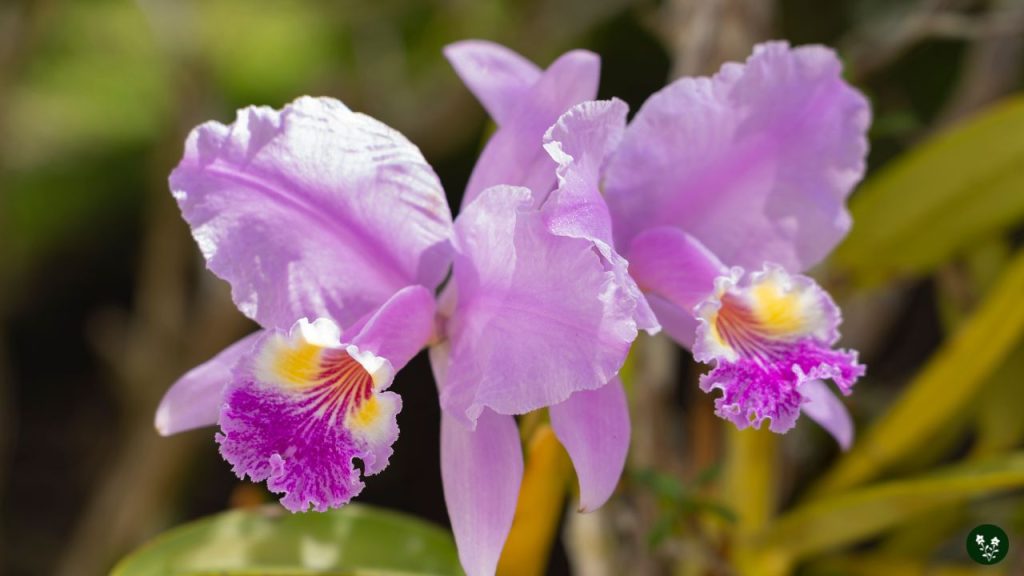
Cattleya orchids, often called Corsage Orchids, are famous for their large, showy flowers that can be found in many colors, including pink, purple, red, yellow, and white.
The blooms often emit a delightful fragrance, making them popular for corsages and bridal bouquets.
Originating from Central and South America, Cattleya orchids are epiphytes, which means they grow on tree trunks and branches in their natural habitat.
To thrive as a houseplant, they require bright light, good air circulation, and a well-draining potting mix.
Care Guide for Corsage Orchid:
| Native area | Central and South America |
| Height | 1-2 ft |
| Light needs | Bright |
| Water needs | Weekly |
| Temperature | 55-85°F (13-29°C) |
| Flowering Season | Spring-Fall |
3. Oncidium (Dancing Lady Orchid)

Oncidium orchids, commonly known as Dancing Lady Orchids, are beloved for their stunning, butterfly-like flowers that sway gracefully on tall, slender stems.
Native to Central and South America, Oncidium orchids come in various colors, including yellow, brown, red, pink, and white.
The flowers often have unique patterns and intricate markings, giving them a striking appearance.
As houseplants, Oncidium orchids require bright, indirect light and a well-draining potting mix to thrive.
With proper care, they can produce multiple flower spikes throughout the year.
Care Guide for Dancing Lady Orchid:
| Native area | Central and South America |
| Height | 1-3 ft |
| Light needs | Bright, indirect |
| Water needs | Weekly |
| Temperature | 55-80°F (13-27°C) |
| Flowering Season | Year-round, depending on species |
4. Dendrobium (Spray Orchid)
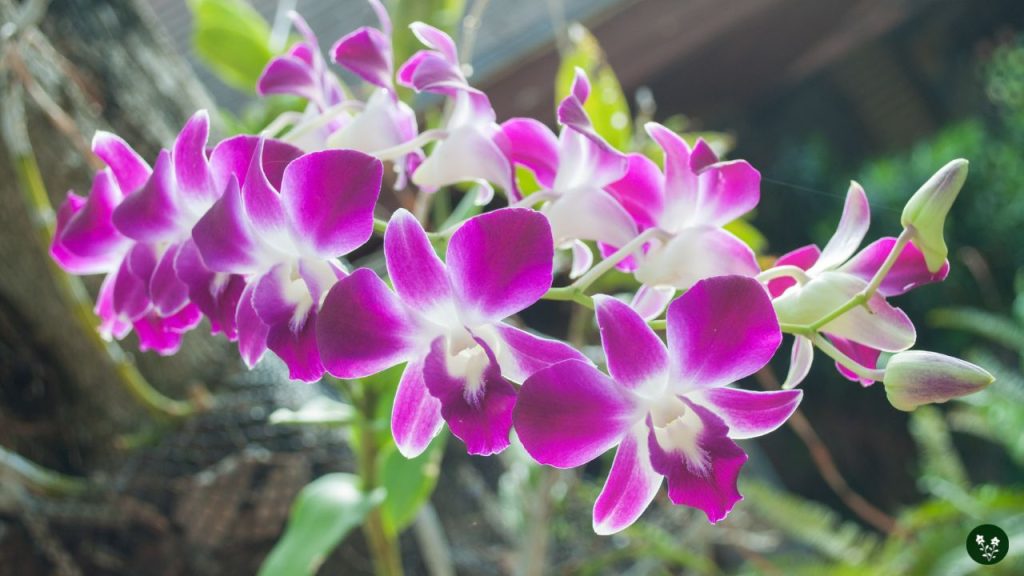
Dendrobium orchids, also known as Spray Orchids, are native to Asia, Australia, and the Pacific Islands.
With over 1,000 species, Dendrobiums are among the most diverse groups of orchids.
They are prized for their elegant, spray-like clusters of flowers that come in a myriad of colors, including white, pink, purple, and yellow.
As houseplants, Dendrobium orchids need bright, indirect light and a well-draining potting mix.
They also require a cooler rest period in the winter to encourage flowering in the spring.
Care Guide for Dancing Spray Orchid:
| Native area | Asia, Australia, Pacific Islands |
| Height | 1-3 ft |
| Light needs | Bright, indirect |
| Water needs | Weekly |
| Temperature | 50-85°F (10-29°C) |
| Flowering Season | Spring-Summer |
5. Paphiopedilum (Lady’s Slipper Orchid)
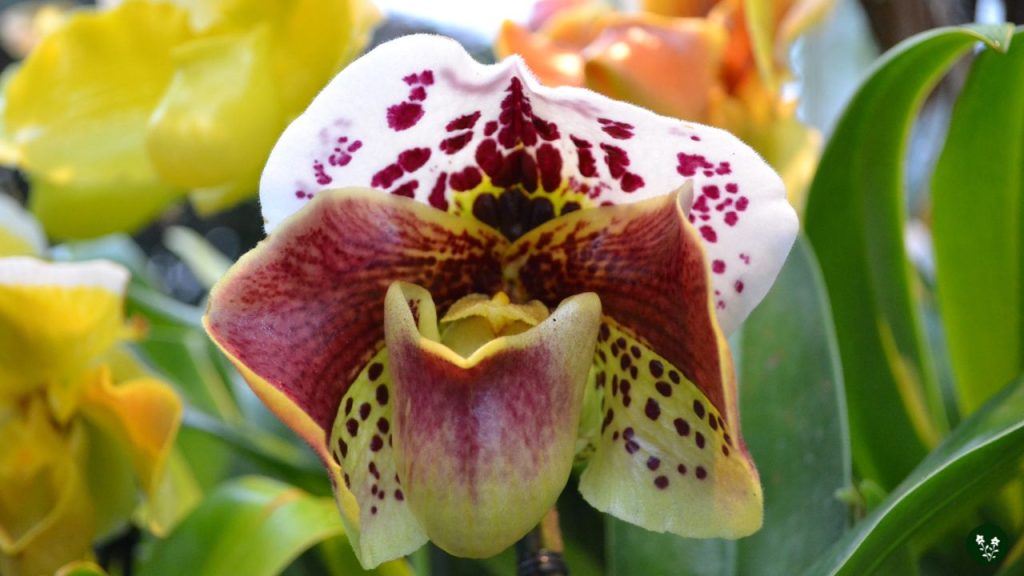
Paphiopedilum, popularly known as the Lady’s Slipper Orchid, a stunning genus of terrestrial orchids native to the tropical and subtropical regions of Asia.
The Lady’s Slipper Orchid is cherished for its unique, pouch-like lip, which resembles a slipper and gives the orchid its distinctive name.
These captivating flowers come in a variety of colors and patterns, with some species even displaying mottled or striped foliage.
To care for a Paphiopedilum, provide low to medium light, a well-draining potting mix like a mix of bark and sphagnum moss, and a temperature range of 55-80°F, depending on the species.
Keep the medium consistently moist but never soggy, and maintain high humidity by using a pebble tray or humidifier.
Paphiopedilum orchids typically bloom from late fall to spring, adding a touch of elegance and intrigue to your indoor garden.
Care Guide for Lady’s Slipper Orchid:
| Native area | Tropical and subtropical Asia |
| Height | 1-2 ft |
| Light needs | Low to medium |
| Water needs | Consistently moist |
| Temperature | 55-80°F |
| Flowering Season | Late fall-Spring |
6. Vanda (Singapore Orchid)
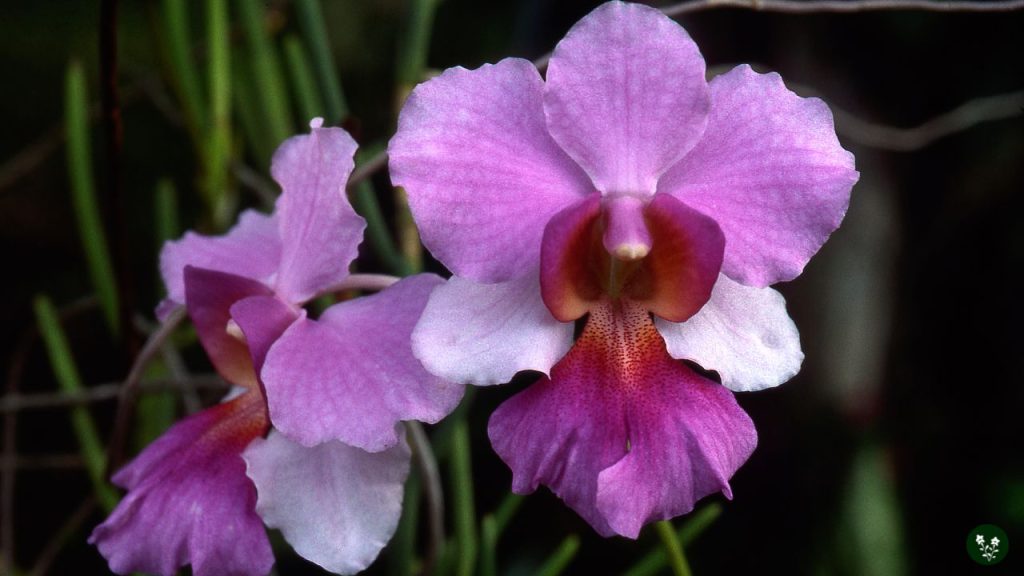
Vanda orchids, also known as Singapore Orchids, are native to Southeast Asia and are renowned for their vibrant, long-lasting flowers.
Vandas come in various colors, including blue, purple, pink, red, and yellow, with many displaying striking patterns.
These orchids are epiphytes, which means they grow on tree trunks and branches in their natural habitat.
As houseplants, they require bright light, high humidity, and good air circulation.
They can be grown in wooden baskets or mounted on slabs to mimic their natural growth habits.
Care Guide for Singapore Orchid:
| Native area | Southeast Asia |
| Height | 2-4 ft |
| Light needs | Bright |
| Water needs | 2-3 times per week |
| Temperature | 60-85°F (15-29°C) |
| Flowering Season | Spring-Summer |
7. Cymbidium (Boat Orchid)
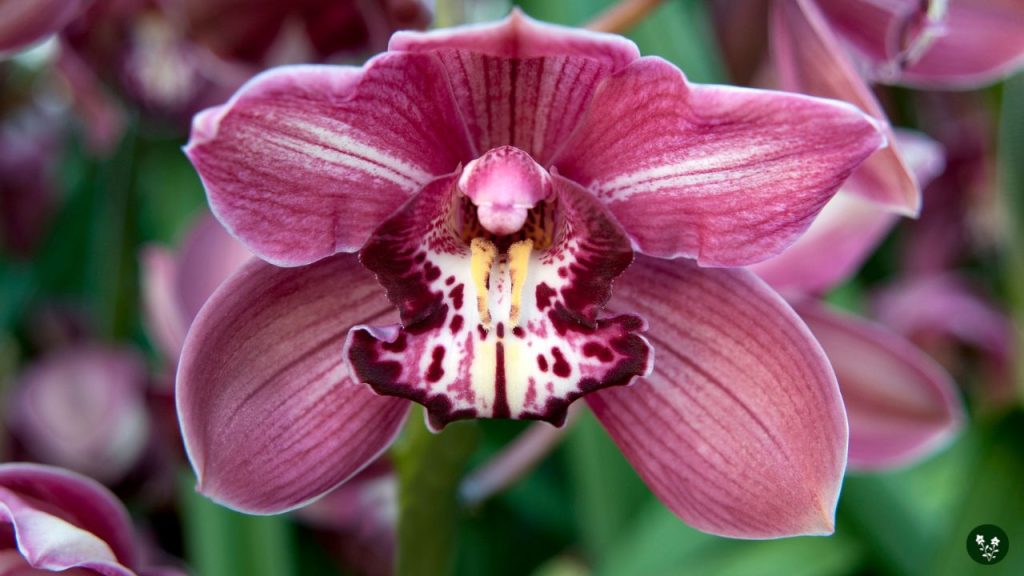
Cymbidium orchids, commonly known as Boat Orchids, are native to Asia and Australia.
They are prized for their large, showy flowers in various colors, including white, pink, red, green, and yellow.
Cymbidiums are also known for their sweet fragrance, making them a favorite choice for floral arrangements.
As houseplants, they prefer bright light, cool temperatures, and a well-draining potting mix.
They can tolerate lower light levels than many other orchids, making them suitable for indoor growing.
Care Guide for Boat Orchid:
| Native area | Asia, Australia |
| Height | 2-3 ft |
| Light needs | Bright |
| Water needs | Weekly |
| Temperature | 45-75°F (7-24°C) |
| Flowering Season | Winter-Spring |
8. Miltoniopsis (Pansy Orchid)
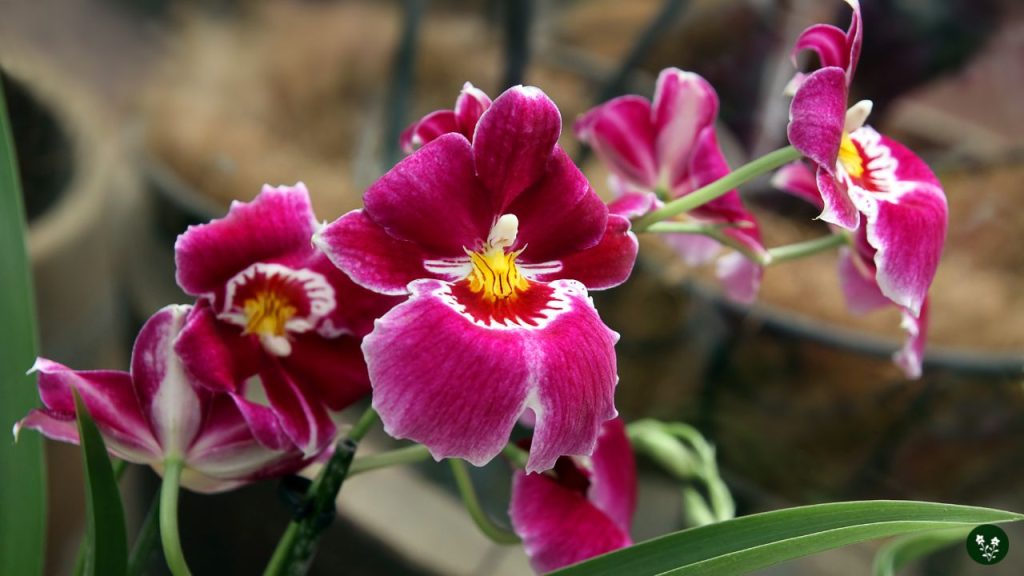
Miltoniopsis orchids, or Pansy Orchids, are native to Central and South America.
They are famous for their large, flat flowers resembling pansies, with vibrant colors like pink, purple, red, and white.
These orchids are known for their captivating fragrance, which can fill a room with their sweet scent.
As houseplants, Miltoniopsis orchids prefer lower light levels and cooler temperatures compared to other orchids. T
hey also require high humidity and a well-draining potting mix to thrive.
Care Guide for Pansy Orchid:
| Native area | Central and South America |
| Height | 1-2 ft |
| Light needs | Low to medium |
| Water needs | Weekly |
| Temperature | 55-75°F (13-24°C) |
| Flowering Season | Spring-Summer |
9. Brassia (Spider Orchid)
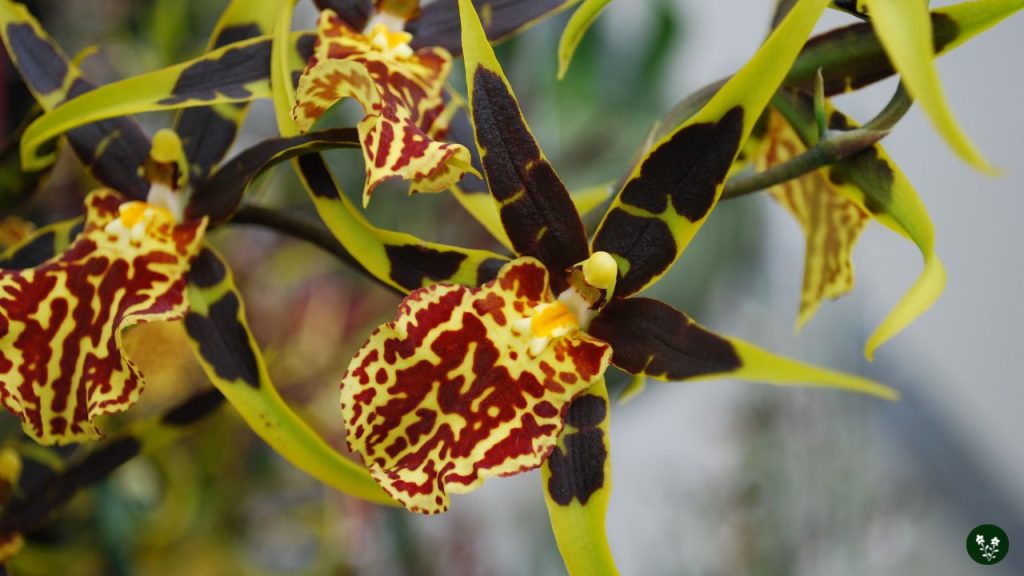
Brassia orchids, also known as Spider Orchids, are native to Central and South America.
They are known for their unique, spider-like flowers in various colors, including green, yellow, and brown.
The long, slender petals and sepals make these orchids look striking and dramatic.
Brassia orchids prefer bright, indirect light and a well-draining potting mix as houseplants.
They are also known for their delightful fragrance, making them a popular choice for orchid enthusiasts.
Care Guide for Spider Orchid:
| Native area | Central and South America |
| Height | 1-2 ft |
| Light needs | Bright, indirect |
| Water needs | Weekly |
| Temperature | 55-80°F (13-27°C) |
| Flowering Season | Spring-Summer |
10. Masdevallia (Triangle Orchid)
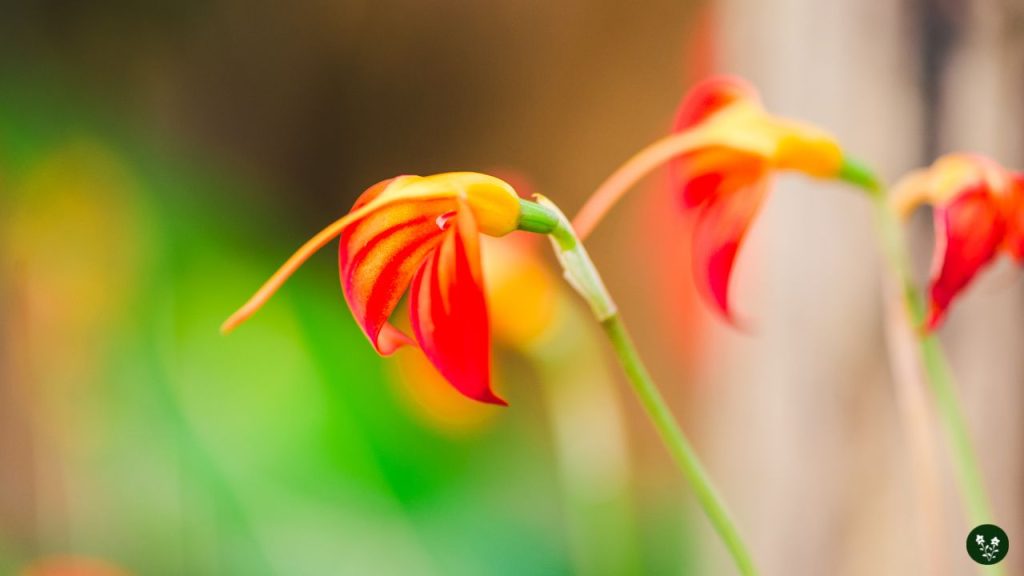
Masdevallia orchids, often called Triangle Orchids, are native to the cool, cloud forests of Central and South America.
They are known for their unique, triangular-shaped flowers in various colors, including red, orange, purple, and white.
These orchids have a compact growth habit, making them an excellent choice for small spaces.
As houseplants, Masdevallias prefer cooler temperatures, high humidity, and low to medium light levels. They also require a well-draining potting mix to prevent root rot.
Care Guide for Triangle Orchid:
| Native area | Central and South America |
| Height | 6-12 inches |
| Light needs | Low to medium |
| Water needs | Weekly |
| Temperature | 55-75°F (13-24°C) |
| Flowering Season | Year-round, depending on species |
11. Epidendrum (Star Orchid)
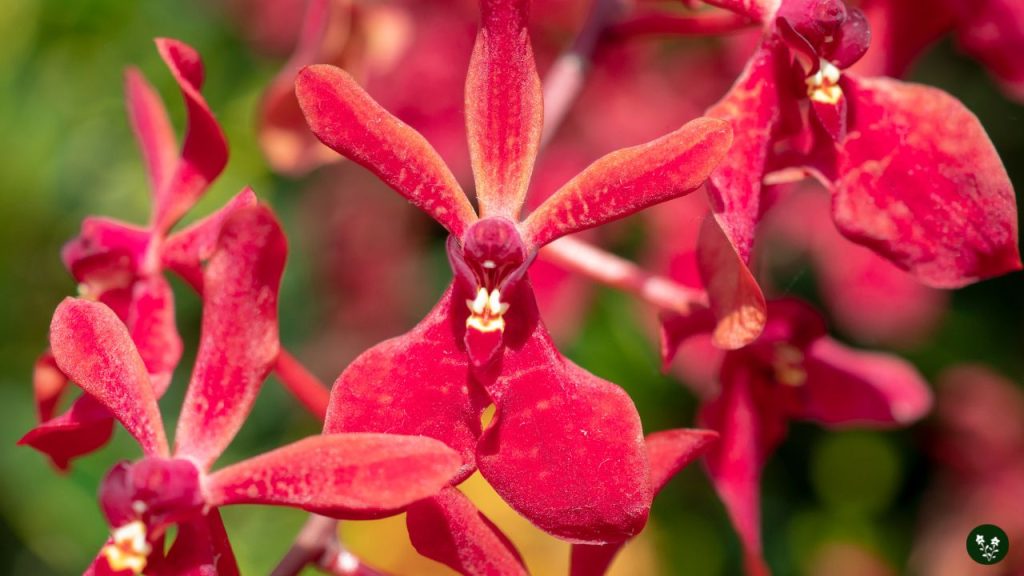
Epidendrum orchids, commonly known as Star Orchids, are native to Central and South America.
They are prized for their colorful, star-shaped flowers that bloom in clusters on tall, slender stems. Epidendrums come in various colors, including red, orange, yellow, and pink.
As houseplants, they require bright light, good air circulation, and a well-draining potting mix.
They can tolerate a wide range of temperatures, making them a versatile choice for orchid growers.
Care Guide for Star Orchid:
| Native area | Central and South America |
| Height | 1-3 ft |
| Light needs | Bright |
| Water needs | Weekly |
| Temperature | 50-85°F (10-29°C) |
| Flowering Season | Year-round, depending on species |
12. Ludisia (Jewel Orchid)
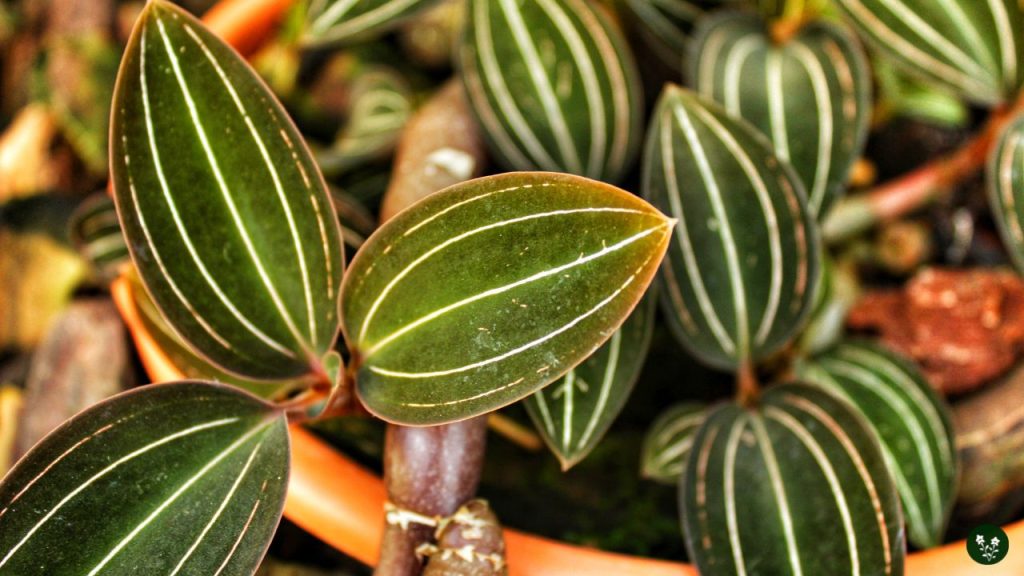
Ludisia orchids, also known as Jewel Orchids, are native to Southeast Asia. They are highly sought-after not only for their delicate white flowers but also for their stunning, velvety foliage.
The leaves come in shades of green and red, with striking silver or gold veins that create a jewel-like appearance.
Ludisias prefer low to medium light levels as houseplants, making them an excellent choice for homes with little natural light.
They also require high humidity and a well-draining potting mix to thrive.
Care Guide for Jewel Orchid:
| Native area | Southeast Asia |
| Height | 6-12 inches |
| Light needs | Low to medium |
| Water needs | Weekly |
| Temperature | 60-80°F (15-27°C) |
| Flowering Season | Winter |
13. Coelogyne (Necklace Orchid)
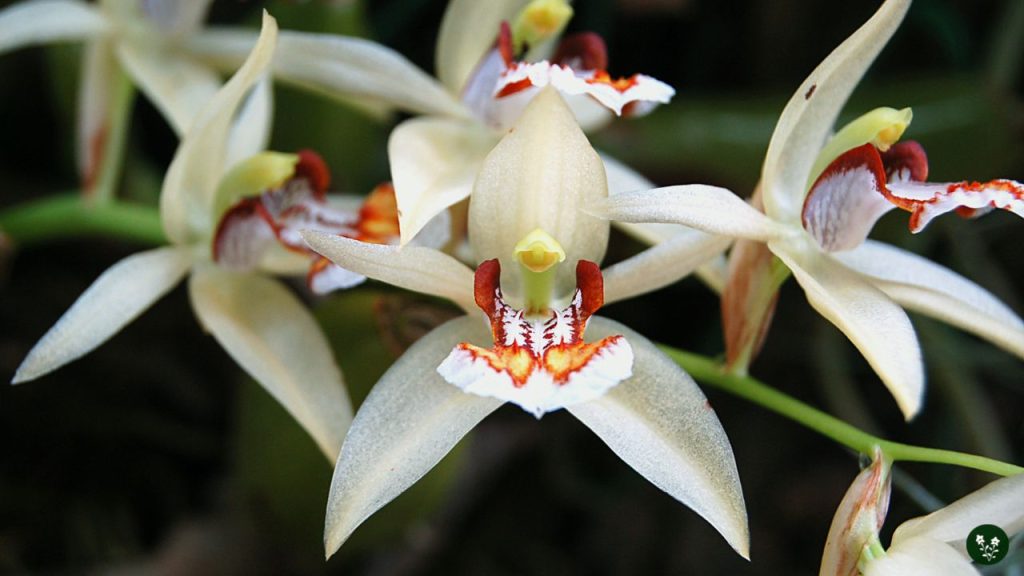
Coelogyne orchids, commonly known as Necklace Orchids, are native to Southeast Asia and the Pacific Islands.
They are appreciated for their elegant, pendant-like clusters of flowers that come in various colors, including white, green, yellow, and brown.
Some Coelogyne species also have a delightful fragrance. As houseplants, they prefer bright, indirect light and a well-draining potting mix.
Coelogynes also require cooler temperatures and high humidity to thrive, mimicking their natural habitat in the cloud forests.
Care Guide for Necklace Orchid:
| Native area | Southeast Asia, Pacific Islands |
| Height | 1-2 ft |
| Light needs | Bright, indirect |
| Water needs | Weekly |
| Temperature | 55-75°F (13-24°C) |
| Flowering Season | Fall-Winter |
14. Encyclia (Cockleshell Orchid)
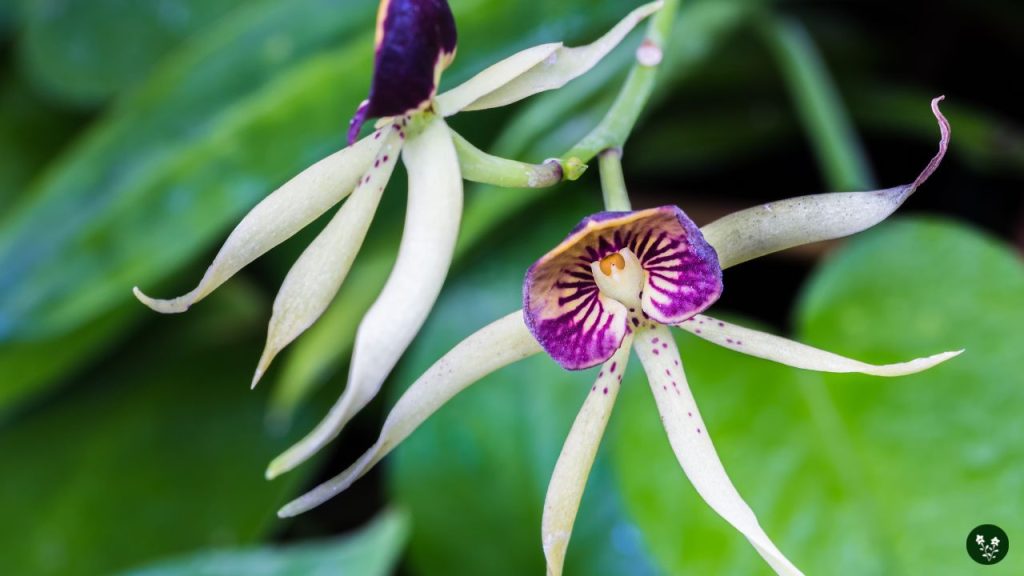
Encyclia orchids, also known as Cockleshell Orchids, are native to Central and South America.
They are known for their unique, shell-like flowers in various colors, including green, brown, and purple. Some species also produce a pleasant fragrance.
Encyclia orchids require bright, indirect light and a well-draining potting mix as houseplants.
They can tolerate various temperatures and humidity levels, making them versatile for indoor growing.
Care Guide for Cockleshell Orchid:
| Native area | Central and South America |
| Height | 1-3 ft |
| Light needs | Bright, indirect |
| Water needs | Weekly |
| Temperature | 50-85°F (10-29°C) |
| Flowering Season | Spring-Summer |
15. Maxillaria (Tiger Orchid)
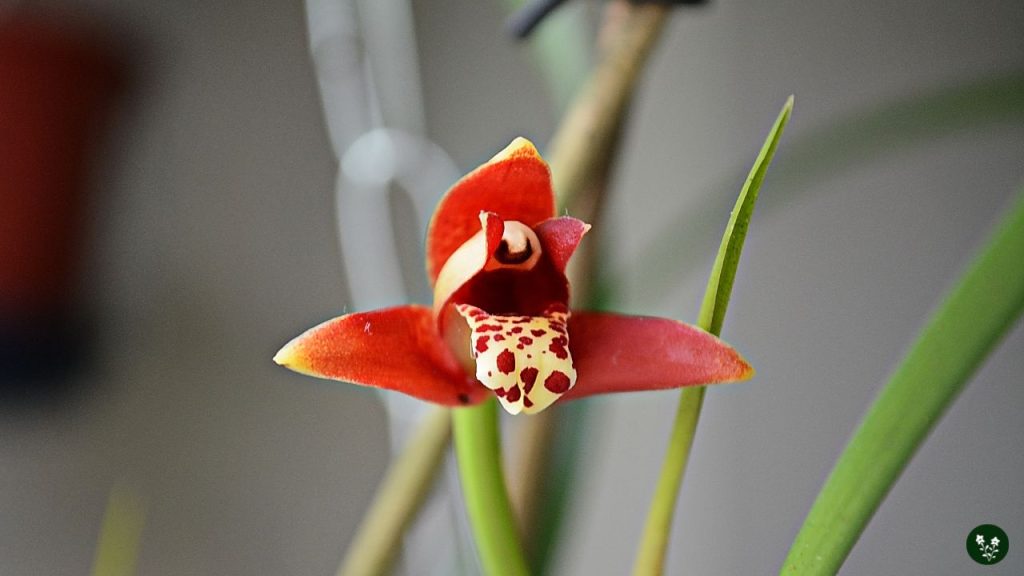
Maxillaria orchid, commonly known as the Tiger Orchid, a diverse genus of both epiphytic and terrestrial orchids that originate from the tropical regions of Central and South America.
The Tiger Orchid is admired for its eye-catching flowers that showcase a wide range of colors and patterns, often featuring bold, tiger-like stripes.
These orchids are not only visually stunning but are also known to emit a pleasant fragrance, making them a delightful addition to your home.
To care for a Maxillaria, provide medium to bright, indirect light, a well-draining potting mix like bark, and a temperature range of 60-80°F.
Keep the medium consistently moist and maintain high humidity by using a pebble tray or humidifier.
Maxillaria orchids typically bloom between late winter and summer, offering a stunning display of color and fragrance that will captivate your senses.
Care Guide for Tiger Orchid:
| Native area | Central, South America |
| Height | 1-3 ft |
| Light needs | Medium to bright, indirect |
| Water needs | Consistently moist |
| Temperature | 60-80°F |
| Flowering Season | Late winter-Summer |
16. Dendrochilum (Chain Orchid)
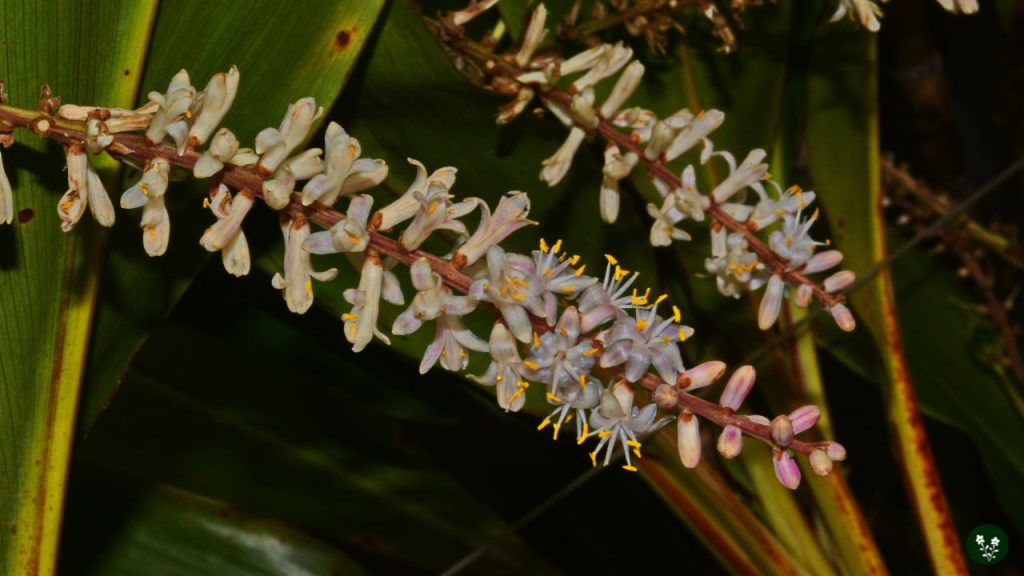
Dendrochilum orchids, often called Chain Orchids, are native to Southeast Asia.
They are known for their unique, chain-like inflorescences that display numerous small, delicate flowers in white, yellow, and orange colors.
These orchids have a graceful, cascading appearance, making them an attractive addition to any home.
As houseplants, Dendrochilum orchids prefer bright, indirect light and a well-draining potting mix. They also require high humidity and moderate temperatures to thrive.
Care Guide for Chain Orchid:
| Native area | Southeast Asia |
| Height | 1-2 ft |
| Light needs | Bright, indirect |
| Water needs | Weekly |
| Temperature | 60-80°F (15-27°C) |
| Flowering Season | Summer-Fall |
17. Zygopetalum (Zygo Orchid)
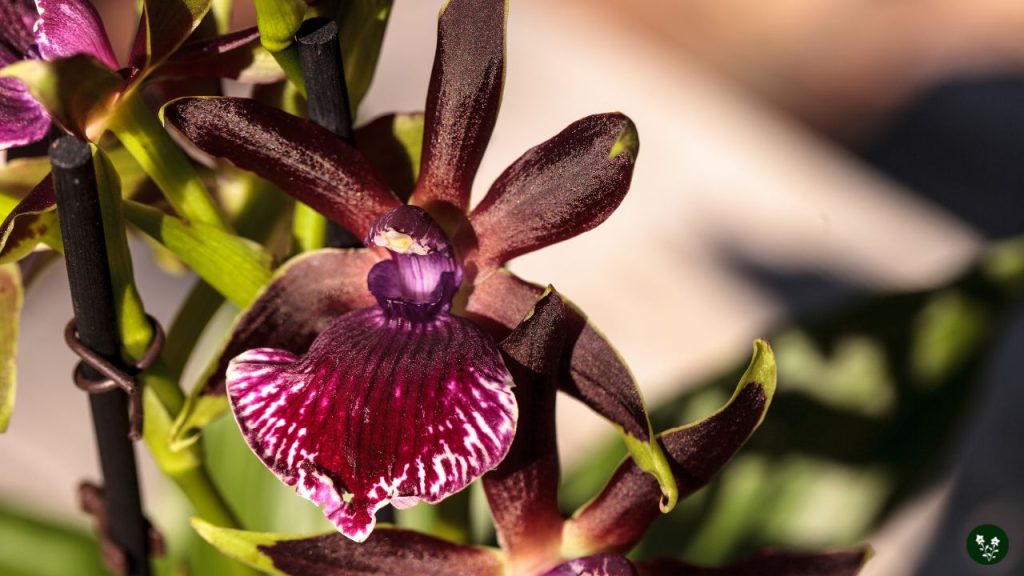
Zygopetalum orchids, commonly known as Zygo Orchids, are native to Central and South America.
They are prized for their large, waxy flowers that come in various colors, including green, purple, and brown, often with striking patterns.
Zygo Orchids are also known for their captivating fragrance, which can fill a room with a sweet, floral scent.
As houseplants, Zygopetalum orchids prefer bright, indirect light and a well-draining potting mix. They also require moderate temperatures and humidity levels to flourish.
Care Guide for Zygo Orchid:
| Native area | Central and South America |
| Height | 1-2 ft |
| Light needs | Bright, indirect |
| Water needs | Weekly |
| Temperature | 55-80°F (13-27°C) |
| Flowering Season | Fall-Winter |
18. Bulbophyllum (Umbrella Orchid)
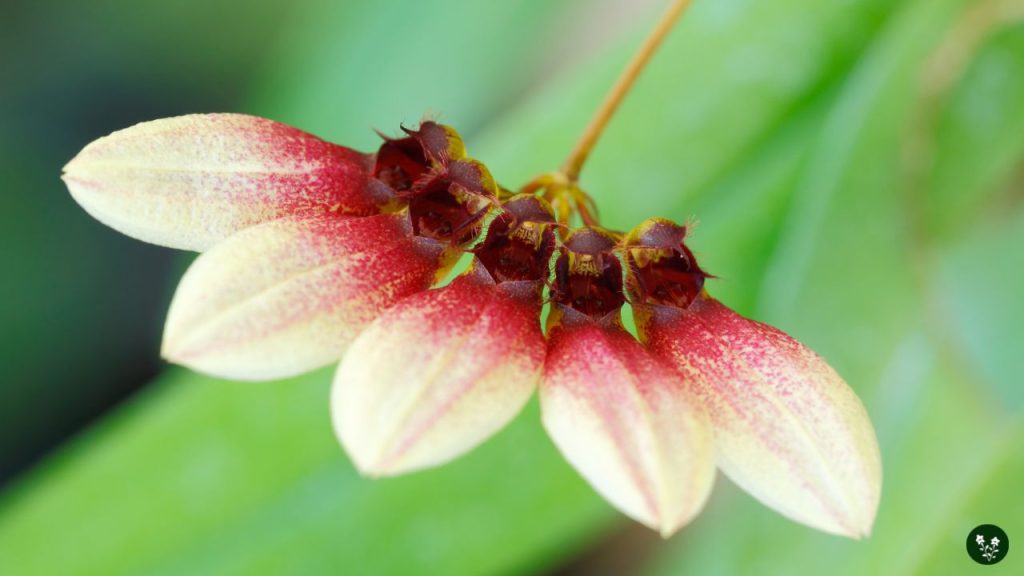
Bulbophyllum orchids, also known as Umbrella Orchids, are native to Southeast Asia, Africa, and the Americas.
They are the largest genus of orchids, boasting over 2,000 species with a wide variety of flower shapes and colors.
Some Bulbophyllum species have intricate, umbrella-like flowers, while others have bizarre, alien-like blooms.
As houseplants, Bulbophyllum orchids prefer low to medium light levels and a well-draining potting mix. They also require high humidity and moderate temperatures to grow well.
Care Guide for Umbrella Orchid:
| Native area | Southeast Asia, Africa, Americas |
| Height | Varies by species |
| Light needs | Low to medium |
| Water needs | Weekly |
| Temperature | 60-80°F (15-27°C) |
| Flowering Season | Varies by species |
19. Odontoglossum (Toothed Lip Orchid)
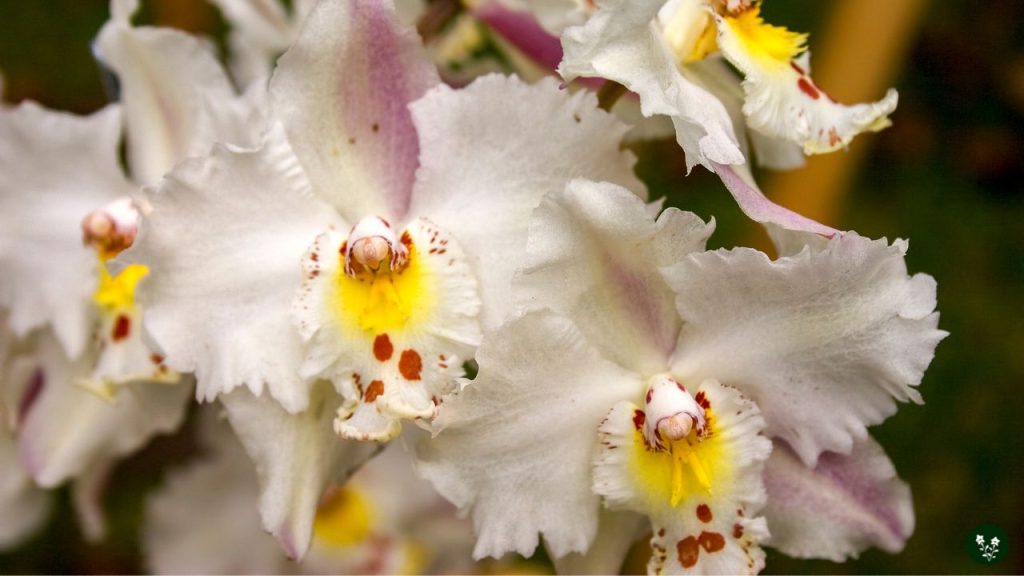
Odontoglossum orchid, known as the Toothed Lip Orchid, an elegant and diverse orchid genus native to the cloud forests of Central and South America.
The name ‘Odontoglossum’ refers to the tooth-like projections on the flower’s lip, giving it an intricate, textured appearance.
These epiphytic orchids are prized for their stunning, long-lasting blooms that come in a wide range of colors and patterns.
To care for an Odontoglossum, provide it with medium to bright, indirect light, a well-draining potting mix like fine bark, and a temperature range of 55-75°F.
Keep the medium consistently moist and ensure high humidity by using a pebble tray or humidifier.
Odontoglossum orchids typically bloom from late fall to spring, adding a touch of elegance and beauty to your home during the cooler months.
Care Guide for Toothed Lip Orchid:
| Native area | Central, South America |
| Height | 1-3 ft |
| Light needs | Medium to bright, indirect |
| Water needs | Consistently moist |
| Temperature | 55-75°F |
| Flowering Season | Late fall-Spring |
20. Catasetum (Helmet Orchid)
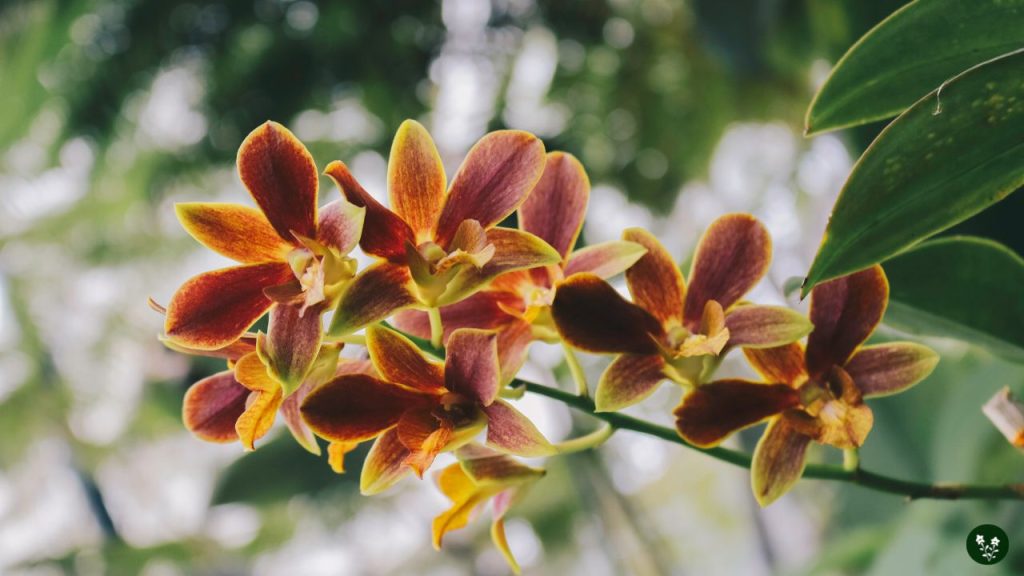
Catasetum orchids, also known as Helmet Orchids, are native to Central and South America. They are known for their unique, helmet-like flowers in various colors, including green, brown, and red. Some species also produce a pleasant fragrance.
Catasetum orchids require bright, indirect light and a well-draining potting mix as houseplants.
They have a distinct growth cycle, with a wet growing season and a dry resting period. During the growing season, they require regular watering and high humidity.
Care Guide for Helmet Orchid:
| Native area | Central and South America |
| Height | 1-2 ft |
| Light needs | Bright, indirect |
| Water needs | Weekly (growing season) |
| Temperature | 60-85°F (15-29°C) |
| Flowering Season | Spring-Summer |
21. Stanhopea (Upside-Down Orchid)
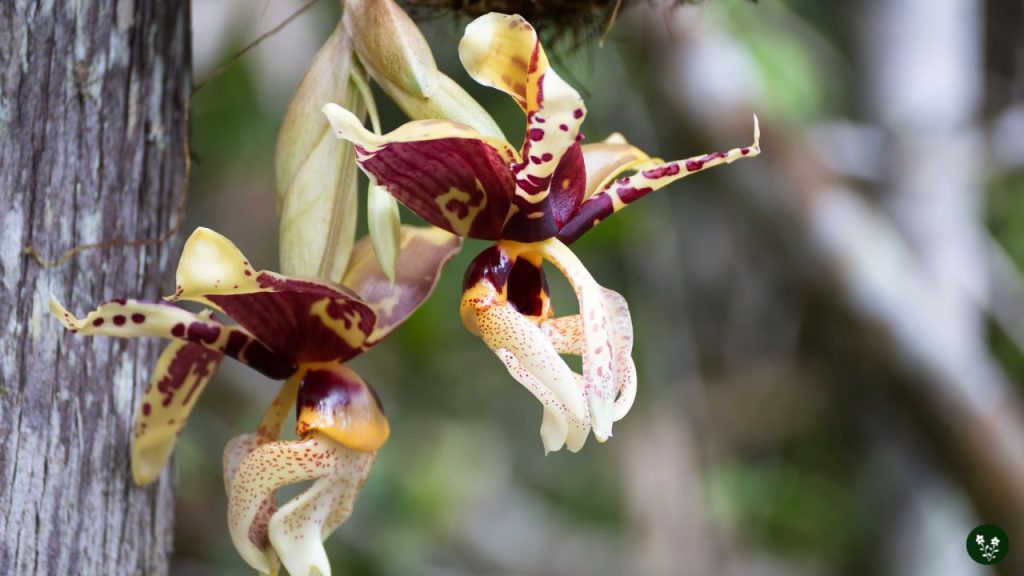
Feast your eyes on the fascinating Stanhopea, also known as the Upside-Down Orchid, a remarkable genus of epiphytic orchids native to the tropical forests of Central and South America.
These captivating orchids are famous for their unique, waxy, pendant-like flowers that dangle upside down from the plant, often emitting a delightful fragrance.
The flowers come in a variety of colors, including yellow, green, and brown, with intricate patterns that add to their allure.
To care for a Stanhopea, provide it with medium to bright, indirect light, and a well-draining potting mix like bark or sphagnum moss.
Keep the medium evenly moist and maintain a temperature range of 55-85°F, depending on the species. High humidity is essential for these orchids, so use a pebble tray or humidifier.
The flowering season for Stanhopea orchids usually falls between summer and fall, making them a unique and exotic addition to your home.
Care Guide for Upside-Down Orchid:
| Native area | Central, South America |
| Height | 1-3 ft |
| Light needs | Medium to bright, indirect |
| Water needs | Evenly moist |
| Temperature | 55-85°F |
| Flowering Season | Summer-Fall |
22. Ansellia (Leopard Orchid)
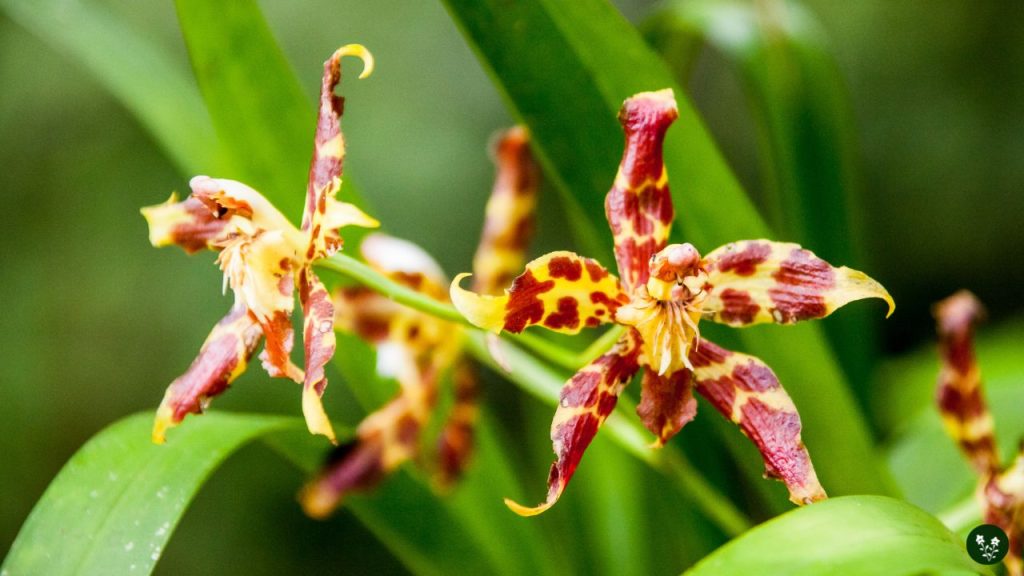
Ansellia orchids, commonly known as Leopard Orchids, are native to Africa. They are admired for their striking, leopard-spotted flowers in various colors, including yellow, green, and brown.
The large, showy flowers are arranged in clusters on tall spikes, making them an eye-catching addition to any home.
As houseplants, Ansellia orchids prefer bright, indirect light and a well-draining potting mix. They also require warm temperatures and moderate humidity to thrive.
Care Guide for Leopard Orchid:
| Native area | Africa |
| Height | 2-4 ft |
| Light needs | Bright, indirect |
| Water needs | Weekly |
| Temperature | 65-85°F (18-29°C) |
| Flowering Season | Spring-Summer |
23. Brassavola (Lady of the Night Orchid)
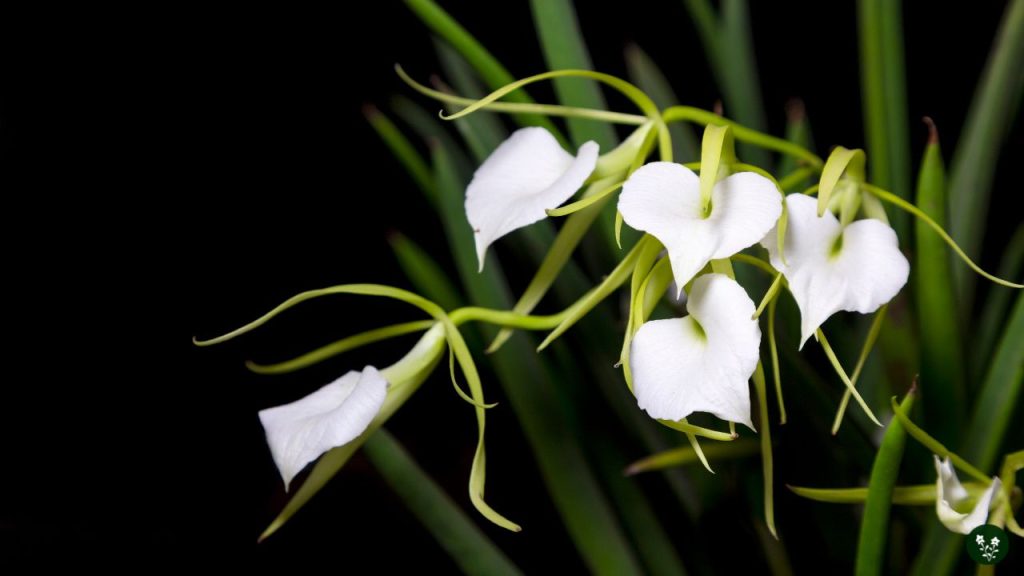
Brassavola orchids, also known as Lady of the Night Orchids, are native to Central and South America. They are prized for their elegant, tubular flowers that come in shades of white and green.
Brassavola orchids are also known for their captivating, sweet fragrance that intensifies at night.
As houseplants, Brassavola orchids prefer bright, indirect light and a well-draining potting mix. They also require warm temperatures and moderate humidity to flourish.
Care Guide for Lady of the Night Orchid:
| Native area | Central and South America |
| Height | 1-2 ft |
| Light needs | Bright, indirect |
| Water needs | Weekly |
| Temperature | 60-85°F (15-29°C) |
| Flowering Season | Spring-Summer |
24. Renanthera (Fire Orchid)
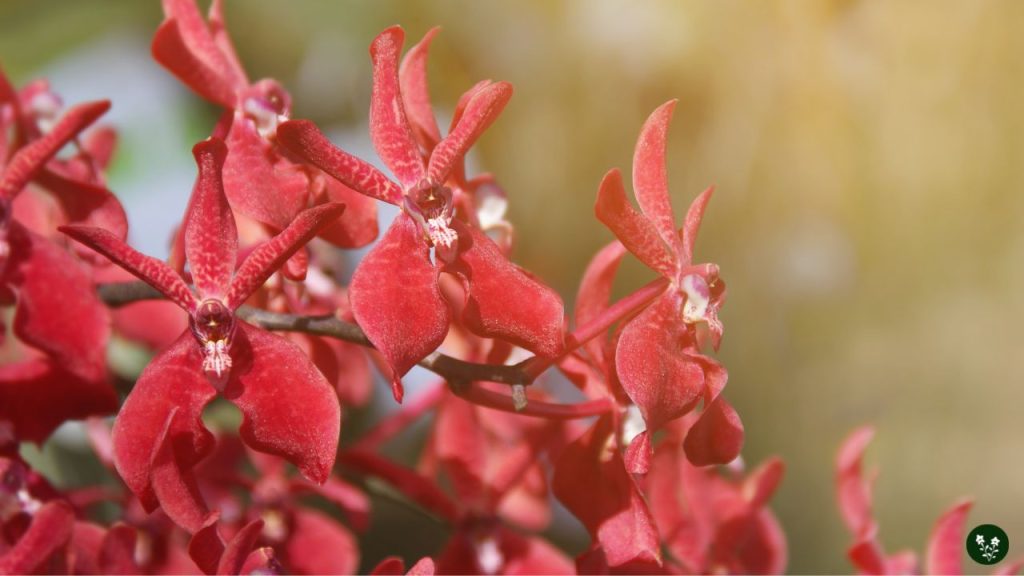
Renanthera orchids, commonly known as Fire Orchids, are native to Southeast Asia. They are admired for their vibrant, fiery-red flowers, creating a stunning visual display.
The flowers often appear in dense clusters on long, arching stems. As houseplants, Renanthera orchids prefer bright light and a well-draining potting mix.
Growing well requires warm temperatures, high humidity, and regular watering.
Care Guide for Fire Orchid:
| Native area | Southeast Asia |
| Height | 2-4 ft |
| Light needs | Bright |
| Water needs | Weekly |
| Temperature | 65-85°F (18-29°C) |
| Flowering Season | Spring-Summer |
25. Laelia (Sun Orchid)
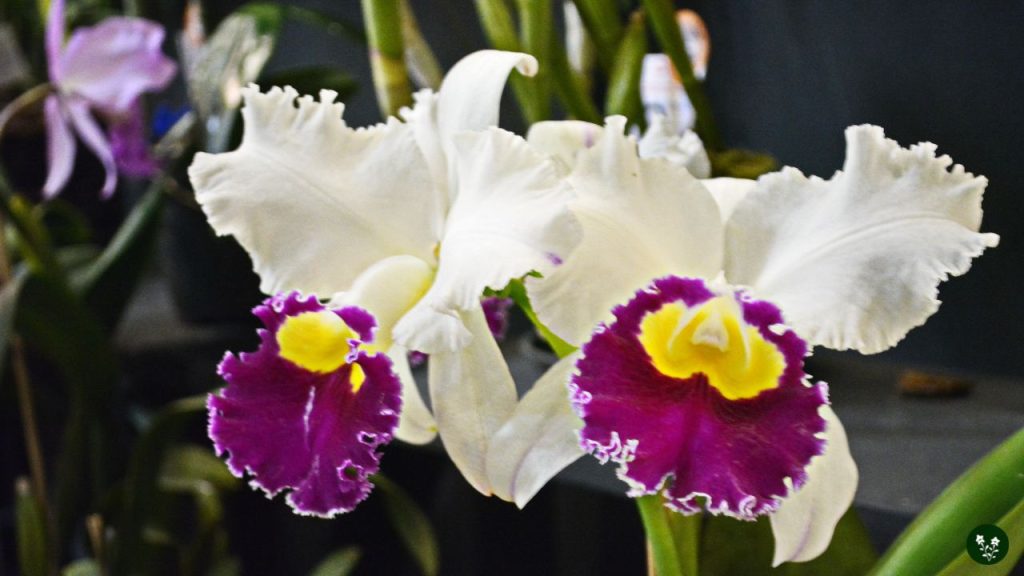
Laelia orchids, commonly known as Sun Orchids, are native to Mexico and Central America.
They are known for their vibrant, showy flowers that come in various colors, including pink, purple, yellow, and white. Some Laelia species also produce a delightful fragrance.
As houseplants, Laelia orchids prefer bright light and a well-draining potting mix. They also require intermediate to warm temperatures, moderate humidity, and regular watering to grow well.
Care Guide for Sun Orchid:
| Native area | Mexico and Central America |
| Height | 1-3 ft |
| Light needs | Bright |
| Water needs | Weekly |
| Temperature | 55-85°F (13-29°C) |
| Flowering Season | Winter-Spring |
26. Lycaste (Angel Orchid)

Lycaste orchid, also known as the Angel Orchid, a captivating genus of terrestrial and epiphytic orchids native to Central and South America.
These charming orchids boast large, waxy flowers with a pleasant fragrance, and their color palette ranges from pastel shades to vibrant hues.
To grow a Lycaste, place it in a spot with medium to bright, indirect light, and use a well-draining potting mix.
Keep the medium evenly moist, but reduce watering during the plant’s winter dormancy period. Lycaste orchids appreciate a temperature range of 55-85°F, depending on the species.
Expect these enchanting flowers to bloom from winter to spring, filling your home with their heavenly scent and delicate beauty.
Care Guide for Angel Orchid:
| Native area | Central, South America |
| Height | 1-3 ft |
| Light needs | Medium to bright, indirect |
| Water needs | Evenly moist (reduce in winter) |
| Temperature | 55-85°F |
| Flowering Season | Winter-Spring |
27. Psychopsis (Butterfly Orchid)
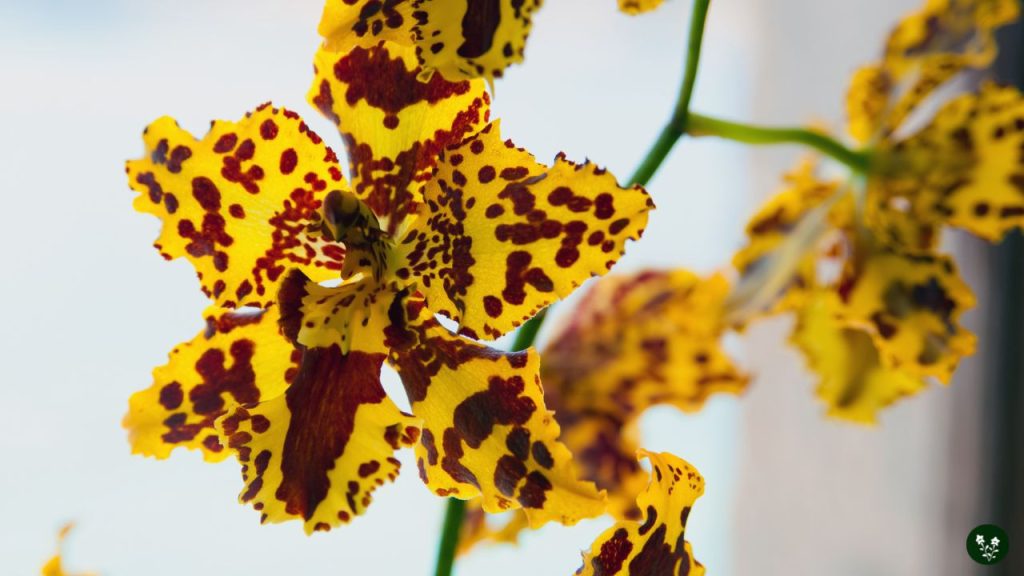
Psychopsis orchids, commonly known as Butterfly Orchids, are native to Central and South America.
They are known for their unique, butterfly-like flowers that come in various colors, including yellow, brown, and green, often with intricate patterns.
As houseplants, Psychopsis orchids prefer bright, indirect light and a well-draining potting mix. They also require warm temperatures, high humidity, and regular watering to thrive.
Care Guide for Butterfly Orchid:
| Native area | Central and South America |
| Height | 1-2 ft |
| Light needs | Bright, indirect |
| Water needs | Weekly |
| Temperature | 65-85°F (18-29°C) |
| Flowering Season | Year-round |
28. Angraecum (Comet Orchid)
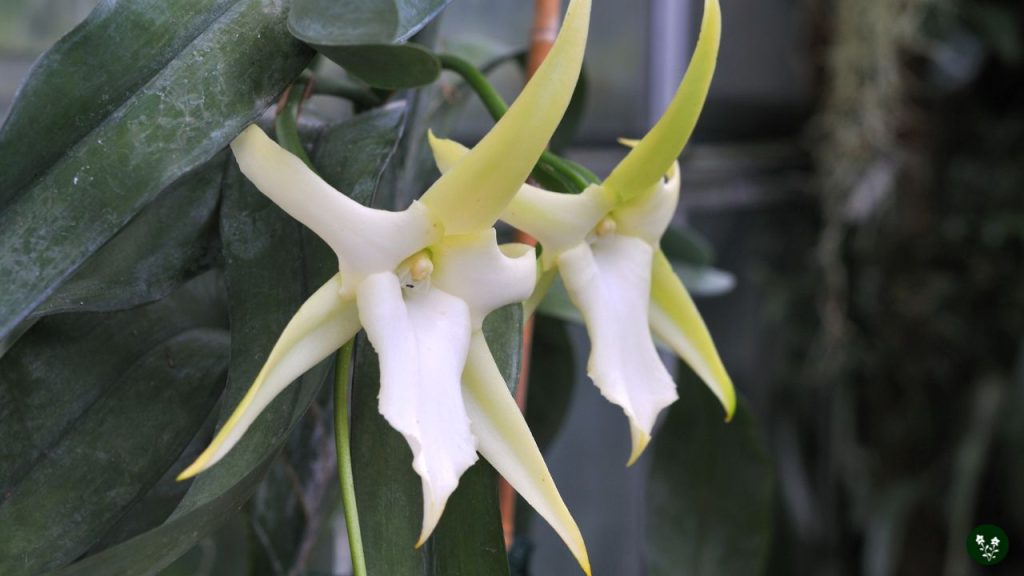
Angraecum orchids, commonly known as Comet Orchids, are native to Africa and Madagascar.
They are known for their captivating, star-shaped flowers that are typically white or greenish-white, often with a long nectar spur. Many Angraecum species also produce a delightful, nocturnal fragrance.
As houseplants, Angraecum orchids prefer bright, indirect light and a well-draining potting mix. They also require intermediate to warm temperatures, high humidity, and regular watering to grow well.
Care Guide for Comet Orchid:
| Native area | Africa and Madagascar |
| Height | 1-2 ft |
| Light needs | Bright, indirect |
| Water needs | Weekly |
| Temperature | 55-85°F (13-29°C) |
| Flowering Season | Winter-Spring |
29. Aerangis (Air Orchid)
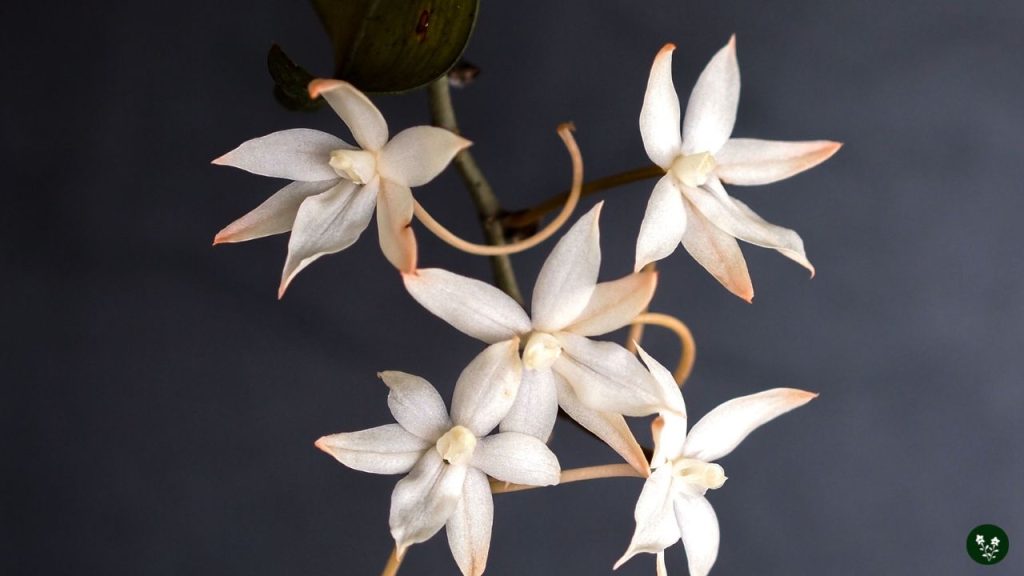
Aerangis orchids, also known as Air Orchids, are native to Africa and Madagascar.
Aerangis species are admired for their delicate, star-shaped flowers that cascade gracefully from slender, pendant-like inflorescences.
To care for an Aerangis, provide it with low to medium light, a well-draining medium like sphagnum moss or a bark mix, and temperatures between 60-85°F.
These orchids require consistent moisture, so water regularly and maintain high humidity.
The flowering season for Aerangis orchids typically falls between late winter and spring, adding a touch of elegance and natural charm to your home.
Care Guide for Air Orchid:
| Native area | Africa, Madagascar |
| Height | 6-12 inches |
| Light needs | Low to medium |
| Water needs | Consistently moist |
| Temperature | 60-85°F |
| Flowering Season | Late winter-Spring |
30. Neofinetia (Samurai Orchid)
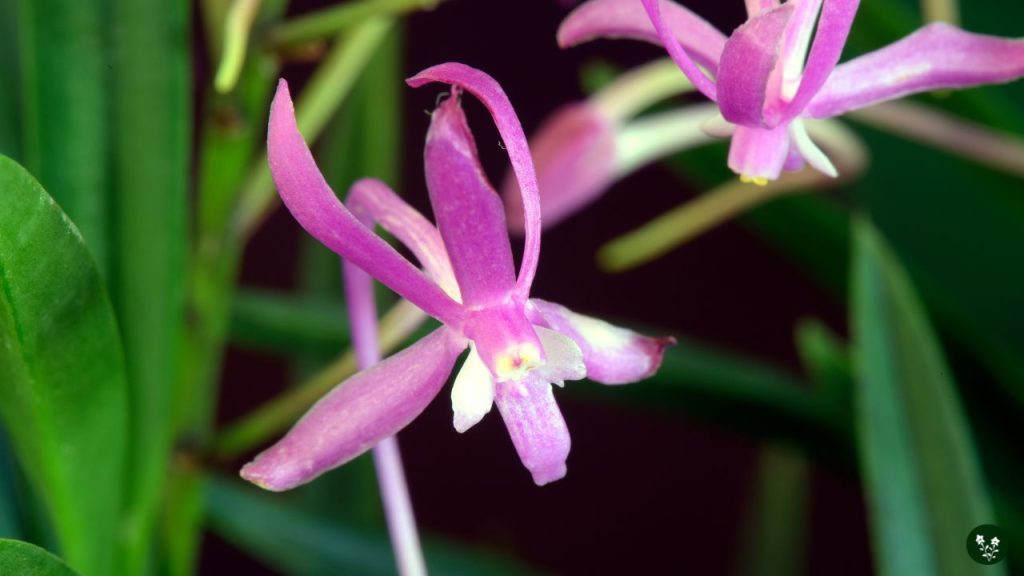
Neofinetia orchids, commonly known as Samurai Orchids, are native to Japan and Korea.
They are known for their small, elegant flowers that are typically white, sometimes with a hint of green or pink. The flowers of Neofinetia orchids also produce a delightful fragrance.
As houseplants, Neofinetia orchids prefer bright, indirect light and a well-draining potting mix. They also require cool to intermediate temperatures, moderate humidity, and regular watering to grow well.
Care Guide for Samurai Orchid:
| Native area | Japan and Korea |
| Height | 6-12 inches |
| Light needs | Bright, indirect |
| Water needs | Weekly |
| Temperature | 50-75°F (10-24°C) |
| Flowering Season | Summer |
31. Phaius (Nun’s Orchid)
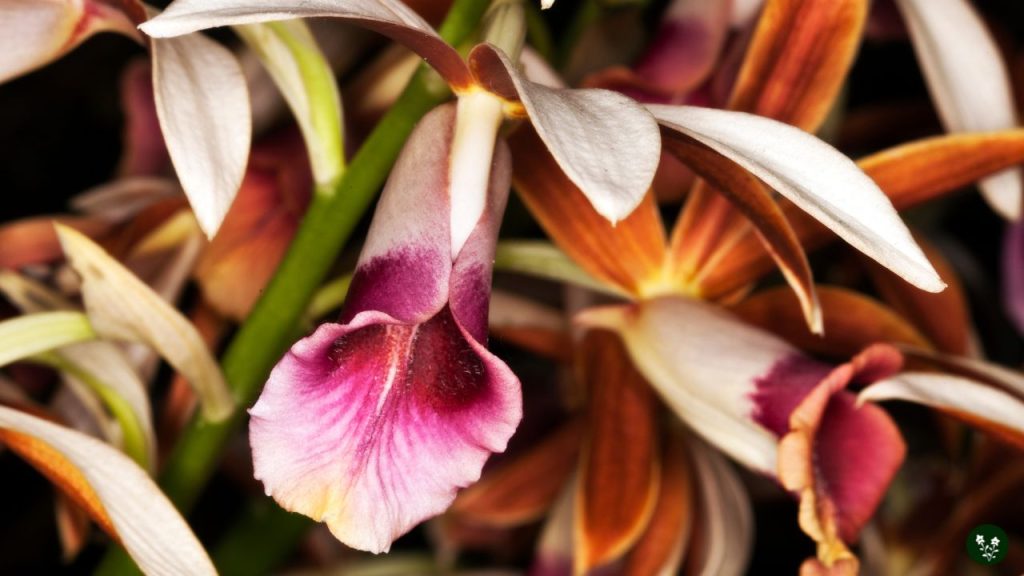
The Phaius, commonly known as Nun’s Orchid, hails from tropical Asia, Australia, and Africa.
This lovely terrestrial orchid stands out with its tall flower spikes adorned with large, showy blooms in colors like white, purple, or yellow. As a houseplant, it’s surprisingly easy to grow, even for beginners.
Simply provide it with bright, indirect light, evenly moist soil, and a well-draining potting mix.
Nun’s Orchids appreciate temperatures between 60-85°F and may require extra humidity, so a humidifier or pebble tray might be helpful. Their flowering season typically occurs from winter to spring.
Care Guide for Nun’s Orchid:
| Native area | Asia, Australia, Africa |
| Height | 2-4 ft |
| Light needs | Bright, indirect |
| Water needs | Evenly moist |
| Temperature | 60-85°F |
| Flowering Season | Winter-Spring |
32. Eria (Foxtail Orchid)
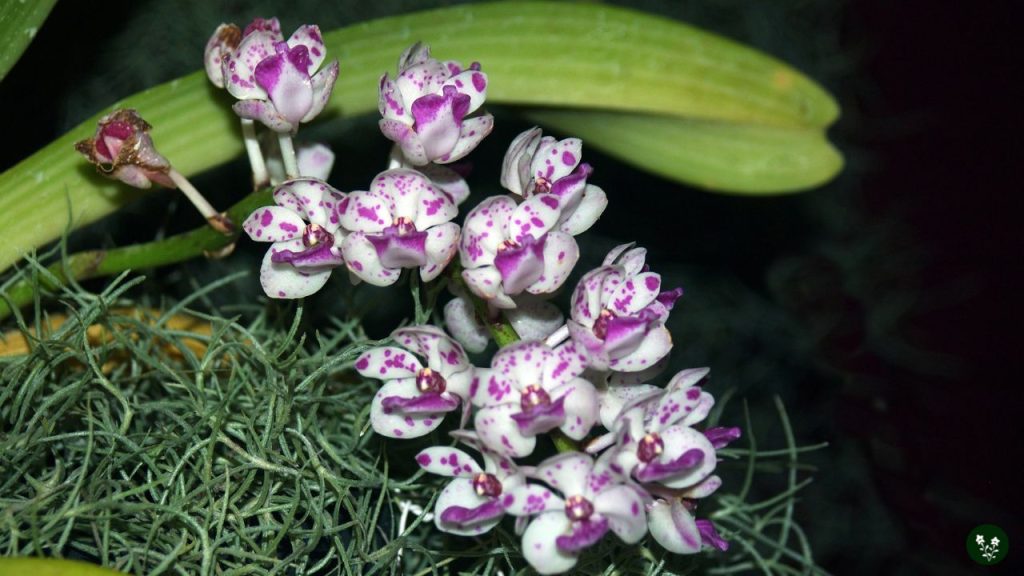
Eria, or Foxtail Orchid, is an enchanting epiphytic orchid species that originates from the Himalayas and Southeast Asia.
It’s named after the foxtail-like appearance of its dense, drooping flower clusters, which come in shades of white, pink, or yellow.
To care for this beauty at home, provide bright, indirect light and a well-draining bark or sphagnum moss mix.
Keep the medium slightly damp, but not soggy, and maintain a temperature range of 50-85°F. Foxtail Orchids bloom from late spring to early summer.
Care Guide for Foxtail Orchid:
| Native area | Himalayas, Southeast Asia |
| Height | 1-2 ft |
| Light needs | Bright, indirect |
| Water needs | Slightly damp |
| Temperature | 50-85°F |
| Flowering Season | Late spring-early summer |
33. Sobralia (Queen Orchid)
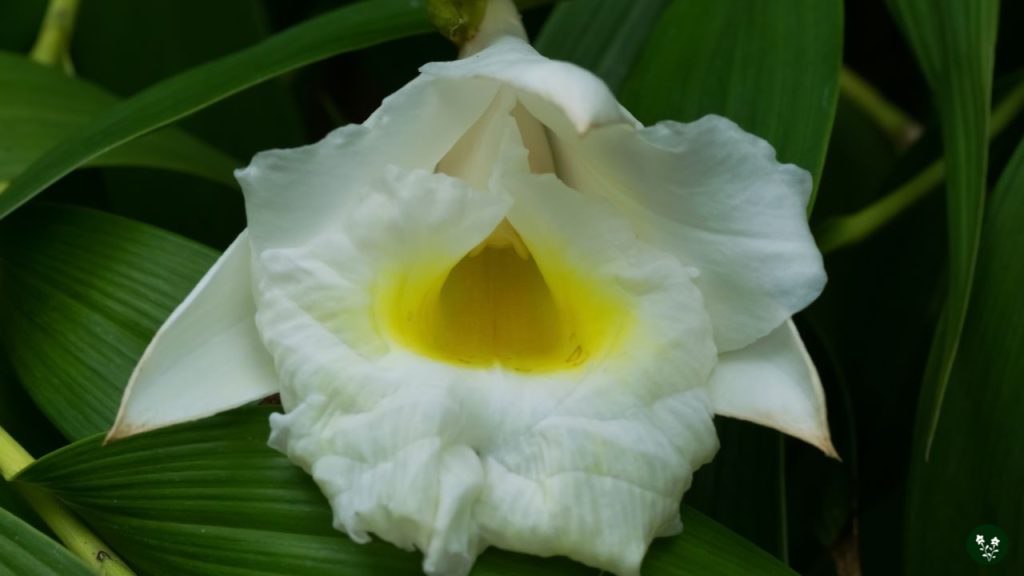
The Sobralia, also known as Queen Orchid, is a majestic terrestrial orchid native to Central and South America.
It’s celebrated for its large, breathtaking flowers that come in a variety of colors, including white, pink, purple, and blue. The blooms may be short-lived, but they are definitely worth the wait.
To grow a Queen Orchid in your home, place it in a spot with bright, indirect light and use a well-draining potting mix. Keep the soil evenly moist, but avoid overwatering.
These orchids thrive in temperatures ranging from 55-85°F and may need extra humidity. Expect the Queen Orchid to grace you with its stunning flowers during the summer and fall seasons.
Care Guide for Queen Orchid:
| Native area | Central, South America |
| Height | 3-8 ft |
| Light needs | Bright, indirect |
| Water needs | Evenly moist |
| Temperature | 55-85°F |
| Flowering Season | Summer-Fall |
34. Tolumnia (Equitant Oncidium)
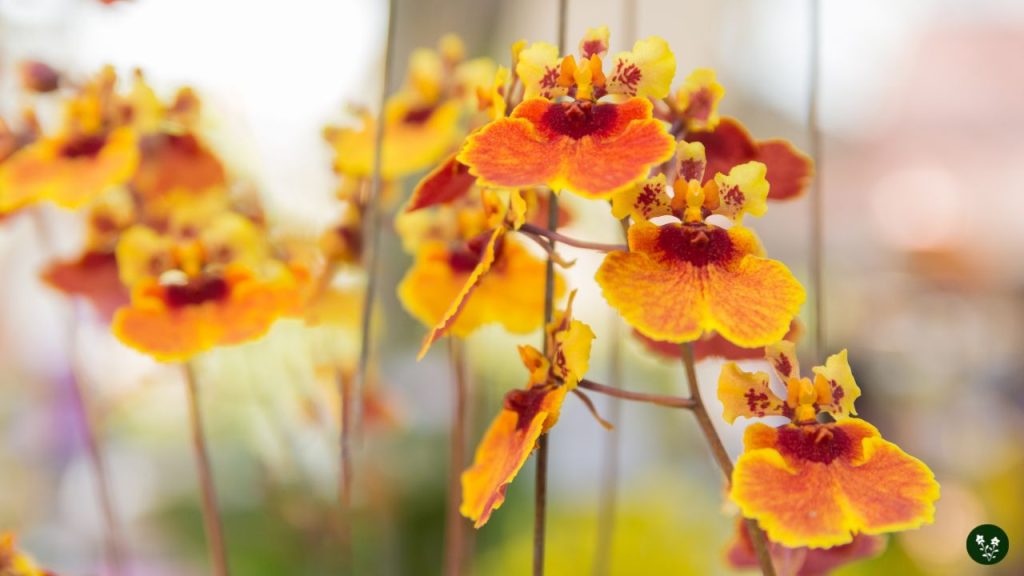
Get ready to be charmed by the Tolumnia, commonly referred to as Equitant Oncidium. This captivating miniature epiphytic orchid is native to the Caribbean and has a unique fan-shaped growth habit.
Its small, delicate flowers come in an impressive array of colors and patterns, often featuring intricate markings that make it a true standout.
Tolumnias are perfect for small spaces and can even be grown mounted on slabs.
They love bright light with some direct sun and require a well-draining medium, such as a mix of fine-grade bark and perlite.
Water them sparingly, allowing the medium to dry between waterings, and maintain a temperature range of 60-85°F.
These little beauties will reward you with blooms from late winter to spring, sometimes even flowering multiple times a year!
Care Guide for Equitant Oncidium Orchid:
| Native area | Caribbean |
| Height | 4-8 inches |
| Light needs | Bright, some direct |
| Water needs | Allow to dry between |
| Temperature | 60-85°F |
| Flowering Season | Late winter-Spring |
35. Dracula (Monkey Face Orchid)
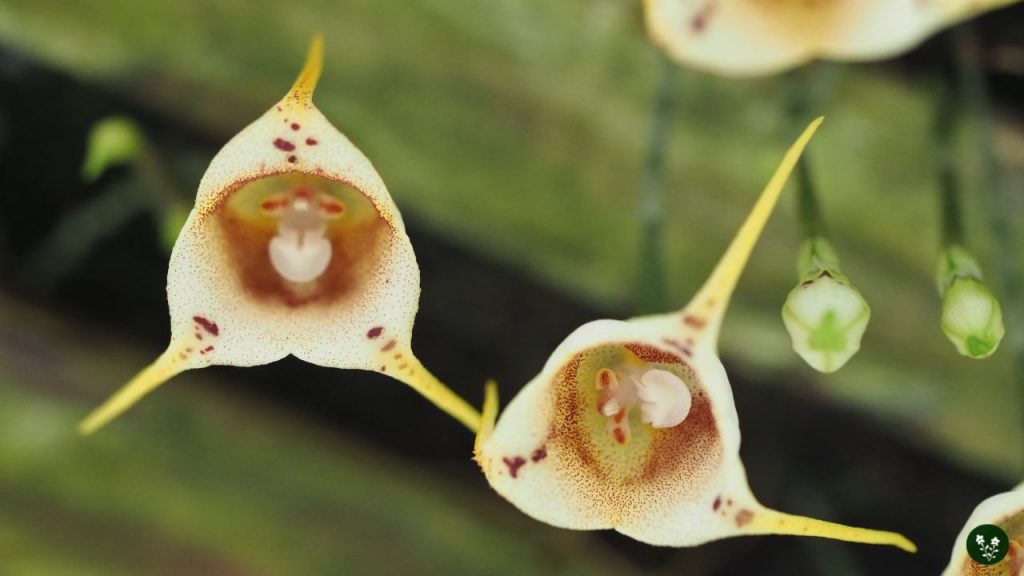
Prepare to be amazed by the whimsical Dracula, or Monkey Face Orchid, a truly one-of-a-kind orchid species native to the cloud forests of Central and South America.
The name ‘Dracula’ refers to the flower’s resemblance to a monkey’s face, with its furry, two-lobed lip and distinct markings.
This epiphytic orchid prefers cooler temperatures (50-70°F) and thrives in a well-draining potting mix of sphagnum moss and bark.
It enjoys low to medium light, making it ideal for rooms with limited natural light. Keep the medium evenly moist, and provide high humidity by placing the orchid in a terrarium or using a humidifier.
Dracula orchids bloom primarily from winter to spring, and their delightfully unique flowers are sure to spark conversations and admiration from anyone who lays eyes on them.
Care Guide for Monkey Face Orchid:
| Native area | Central, South America |
| Height | 6-12 inches |
| Light needs | Low to medium |
| Water needs | Evenly moist |
| Temperature | 50-70°F |
| Flowering Season | Winter-Spring |
In conclusion, the world of orchids offers an incredible array of captivating and diverse species that can be grown as houseplants.
As you explore the different types of orchids, you’ll discover plants with unique features, stunning colors, and enchanting fragrances that can add beauty and charm to any living space.
By understanding their specific care requirements and replicating their natural habitat, even beginners can successfully grow and enjoy these exotic beauties.
So, whether you’re just starting your orchid journey or expanding your collection, let the allure of these fascinating plants inspire you to create your own thriving indoor orchid garden.
Leave a Reply